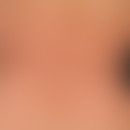Synonym(s)
HistoryThis section has been translated automatically.
DefinitionThis section has been translated automatically.
Rare, inflammatory systemic disease (?) of unclear etiology, whose (clinically uncharacteristic) skin involvement with recurrent, itchy or burning, saturated red solid (eosinophilic) plaques, is the leading clinical symptom. Initially, the clinical picture may resemble erysipelas (fever in 1/4 of cases).
Recurrent course is possible. Later phases are more reminiscent of morphea or mycosis fungoides.
Diagnosis is usually based on its histologic feature (histoeosinophilia with flame figures). Eosinophilic infiltrates of internal organs (eosinophilic pneumonia, pleurisy, pericarditis) are possible but rather rare.
You might also be interested in
Occurrence/EpidemiologyThis section has been translated automatically.
Wells syndrome is a rare dermatosis with less than 200 cases published in the literature.
EtiopathogenesisThis section has been translated automatically.
Unexplained; there is increasing evidence that it is not an entity but a histopathologic reaction pattern to various stimuli. stimuli. Pathogenetically, it is based on a tissue reaction to the release of eosinophil major basic protein (MBP) with the involvement of leukotrienes.
Numerous triggering factors have been reported, including insect bites, viral infections (parvovirus B19, herpes simplex virus, varicella zoster virus, mumps virus), parasitic infections (Ascaris, Toxocara canis, Giardia), bacterial or fungal infections, drugs (antibiotics, non-steroidal anti-inflammatory drugs, thiazide diuretics, biologics) (see also case report). An association of Wells syndrome with other diseases has also been described, e.g. with hematological malignancies (chronic myeloid leukemia, chronic lymphocytic leukemia, polycythemia vera, non-Hodgkin's lymphoma), malignant tumors, ulcerative colitis, eosinophilic granulomatosis with polyangiitis (Churg-Strauss syndrome), hypereosinophilic syndrome). Wells syndrome can precede, reveal or accompany these diseases. It cannot be ruled out that some of these situations occur by chance.
The most interesting associations from a pathogenetic point of view are certainly those belonging to the spectrum of eosinophilic diseases, such as Shulman syndrome, Churg-Strauss syndrome and hypereosinophilic syndrome. Wells syndrome could be the first clinical manifestation of these diseases (Toumi A et al. 2024)
The physiopathogenic relationships between the triggering factors and the above-mentioned associations are not clearly understood. Pathological activation of a Th2-like T lymphocyte clone that synthesizes IL-5 and other eosinophil-stimulating cytokines in response to various, often unidentified antigenic stimuli is the generally accepted assumption.
Associations with atopy(atopic dermatitis) and vaccination have been described in children, for example after COVID-19 vaccination (Montjoye L et al. 2022).
In adulthood, (eosinophilia-inducing) medication can also be a trigger (see case report). The following have been described as triggering: NSAIDs; antibiotics, TNF-alpha blockers, thyroid therapeutics.
ManifestationThis section has been translated automatically.
Children (often with signs of atopy) 4-10 years
Adults: 40-60 years
Clinical featuresThis section has been translated automatically.
Biphasic course of disease. Acute onset.
- Early stage: First unspecific, but mostly pronounced pruritus, possibly combined with burning; within a few days formation of circumscribed, mostly large-area, sharply defined erythema, dolent swellings and doughy to firm large-area plaques. The surface of the plaques may have an orange peel-like texture (see figure). Blistering or bubble formation is rare.
- Fatigue, tiredness and arthralgias can accompany this. The initial stdium can resemble acute erysipelas.
- Late stage: Granulomatous dermatitis with eosinophilia. Plaques that persist for weeks and become increasingly firm, doughy, firm consistency; surface smooth, possibly formation of livid-grey, morphea-like indurations, also strongly itchy prurigo-like papules or nodes. Progression in stages, so that several stages can exist side by side.
- Associated symptoms: Facial paralysis possible. Other systemic involvement is rare.
LaboratoryThis section has been translated automatically.
HistologyThis section has been translated automatically.
Focally dense, perivascularly and interstitially stored infiltrates, almost exclusively consisting of eosinophilic and (few) neutrophilic granulocytes, which may also be stored around adnexa. Focal, polygonally limited, eosinophilic flame figures in the dermis.
Notice! "Flame figures are formed by coating collagenous fibres with eosinophilic granules. Circumscript collagen necrosis, eosinophilocytoclasia, granulomatous reaction.
| Accentuated around post-capillary venules |
| Capillaries recessed |
| perivascular leukocytoclasia |
| Damage to endothelial cells |
| Fibrin in/around vessel walls |
| Perivascular extravasation of erythrocytes |
| Edema in the papillary dermis |
| Collagen degeneration |
| Eosinophil infiltrates with flame figures, palisade granulomas |
| No plasma cells or fibrosclerosis |
Differential diagnosisThis section has been translated automatically.
Clinical:
- Erysipelas
- circumscritic scleroderma
- dermatitis herpetiformis
- Urticariavasculitis
- Urticaria
- Eosinophilic anular erythema
- Erythema anulare centrifugum
Histologic:
- Churg-Strauss syndrome (signs of vasculitis).
- Arthropod reaction (wedge-shaped eosinophilic infiltrate)
- Erythema anulare centrifugum (eosinophilia is not predominant)
External therapyThis section has been translated automatically.
Radiation therapyThis section has been translated automatically.
Internal therapyThis section has been translated automatically.
Corticosteroids: Corticosteroids are the standard therapy for all reactive dermatoses, regardless of whether they are neutrophilic or eosinophilic. General corticosteroid therapy reduces the duration and severity of relapses in 10% of cases[2]. The initial dose is between 0.5 and 1 mg/kg/day, with the dose being rapidly reduced. When treatment is discontinued, it is not uncommon for lesions to relapse, which in certain cases can lead to true corticosteroid dependence. Local corticosteroids represent an interesting alternative to general corticosteroids, especially for superficial forms, with inconsistent results in the order of 50%, but should not be used for deep subcutaneous or extensive forms (Toumi A et al. 2024).
Dapsone: Dapsone is a therapeutic alternative to corticosteroids, with doses ranging from 50 to 200 mg daily. It would shorten the duration of relapses. The optimal duration of treatment is not clearly defined, but may be several months if there are no adverse effects requiring discontinuation of treatment. It can be used alone or in combination with other treatments, including corticosteroids. It can also be used as a substitute for general corticosteroids, especially in cases of corticosteroid dependence.
Antihistamines: Antihistamines, especially hydroxyzine for pruritus, are important and can be tried as a first measure as they are very well tolerated, even if their efficacy seems to be given in only 25% of cases. They sometimes allow the doctor to avoid general steroid treatment. The dosage varies between 50 and 100 mg/day. Hydroxyzine can be combined with other antihistamines.
Other treatments: These are all anecdotal: colchicine, PUVA therapy (psoralen and ultraviolet A), interferon-alpha, cyclins [17], synthetic antimalarials, ciclosporin and anti-TNF blockers (Stam-Westerveld EB et al. 1998; Sarin KY et al. 2012; Husak R et al. 1997).
In recurrent cases, the combination of systemic glucocorticoids with DADPS (e.g. dapsone fatol) has proven successful, starting with 100 mg/day DADPS p.o. Rapid dose reduction within the next few weeks to a maintenance dose of 50 mg/day p.o. according to the skin findings.
Progression/forecastThis section has been translated automatically.
Untreated, spontaneous remission occurs after several weeks to months. Chronic recurrent course over many months is possible. Patients with Wells syndrome may develop signs of eosinophilic systemic vasculitis ( e.g. eosinophilic granulomatosis with polyangiitis).
Case report(s)This section has been translated automatically.
A 57-year-old female patient reported on intensively itchy, blurred fibrously bordered, high red, moderately doughy-consistent, 10x8cm large, surface smooth plaques on the left thigh, which had been present for 1-2 days and had appeared for the first time. Individual satelite-like papules and plaques were localized in the immediate vicinity of the primary focus. No fever or other AZ disorders. Laboratory findings were leukocytosis (11,000 leukocytes/ml), with distinct eosinophilia (18%) and slightly increased inflammatory parameters. Because of a known but not progressive breast cancer, the patient took tamoxifen.
Histological examination revealed: Focal dense perivascular and interstitial infiltrates almost exclusively of eosinophilic and (few) neutrophilic granulocytes. Detection of eosinophilic flame figures in the dermis.
Therapy: Rapid remission was observed with the use of topical class III glucocorticoids. In the following 2 months 2 relapses occurred in loco, which responded to topical therapy. The blood eosinophilia persisted in unchanged level.
LiteratureThis section has been translated automatically.
- Afsahi V et al (2003) Wells syndrome. Cutis 72: 209-212
- Brehmer-Andersson E, Kaaman T, Skog E, Frithz A (1986) The histopathogenesis of the flame figure in Wells syndrome based of five cases. Acta Derm Venerol (Stockh) 66: 213-219
- Brun J et al. (2015) Groupe de Recherche de la Société française de dermatologie pédiatrique. Wells Syndrome in children and atopy: Retrospective study of 11 cases and review of the literature. Ann Dermatol Venereol doi: 10.1016/j.annder.2015.02.017
- de Montjoye L et al. (2022) Eosinophilic cellulitis after BNT162b2 mRNA Covid-19 vaccine. J Eur Acad Dermatol Venereol 36: e26-e28.
- Fujii K et al. (2003) Eosinophilic cellulitis as a cutaneous manifestation of idiopathic hypereosinophilic syndrome. J Am Acad Dermatol 49: 1174-1177
- Heelan K et al (2013) Wells syndrome (eosinophilic cellulitis): Proposed diagnostic criteria and a literature review of the drug-induced variant. J Dermatol Case Rep 7:113-120
- Husak R et al. (1997) Interferon alfa treatment of a patient with eosinophilic cellulitis and HIV infection. N Engl J Med 337:641-642.
- Long H et al. (2015) Eosinophilic Skin Diseases: A Comprehensive Review. Clin Rev Allergy Immunol PubMed PMID: 25876839.
- Rajpara A et al. (2014) Recurrent paraneoplastic wells syndrome in a patient with metastatic renal cell cancer. Dermatol Online J 20. pii: 13030/qt35w8r1g3
- Ratzinger G et al. (2015) The vasculitis wheel-an algorithmic approach to cutaneous vasculitis. JDDG 1092-1118
- Sinno H et al. (2012) Diagnosis and management of eosinophilic cellulitis (Wells' syndrome): A case series and literature review. Can J Plast Surg 20:91-97
- Sarin KY et al. (2012) Treatment of recalcitrant eosinophilic cellulitis with adalimumab. Arch Dermatol 148:990-992.
- Stam-Westerveld EB et al (1998) Eosinophilic cellulitis (Wells' syndrome): treatment with minocycline. Acta Derm Venereol 78:157.
- Toumi A et al. (2024) Wells syndrome In: StatPearls [Internet]. Treasure Island (FL): StatPearls Publishing; 2024 Jan-. PMID: 30335327.
- Wells GC (1971) Recurrent granulomatous dermatitis with eosinophilia. Trans St Johns Hosp Dermatol Soc 57: 46-56
- Wells GC, Smith NP (1979) Eosinophilic cellulitis. Br J Dermatol 100: 101-109
Incoming links (12)
Betamethasone valerate emulsion hydrophilic 0,025/0,05 or 0,1 % (nrf 11.47.); Dermatitis, granulomatous, recurrent with eosinophilia; Dermatitis, granulomatous with eosinophilia; Eosinophilia and skin; Eosinophilic cellulite; Eosinophilic granulomatosis with polyangiitis; Eosinophil infiltrate of the skin; Erythema anulare centrifugum; Hypereosinophilic dermatitis; Sweet syndrome; ... Show allOutgoing links (15)
Antihistamines; Atopic dermatitis (overview); Betamethasone valerate emulsion hydrophilic 0,025/0,05 or 0,1 % (nrf 11.47.); Circumscripts of scleroderma (overview); Dadps; Dermatitis herpetiformis; Eosinophilic granulomatosis with polyangiitis; Erysipelas; Erythema anulare centrifugum; Glucocorticosteroids; ... Show allDisclaimer
Please ask your physician for a reliable diagnosis. This website is only meant as a reference.











